service schedule Alfa Romeo 8C 2010 Owner handbook (in English)
[x] Cancel search | Manufacturer: ALFA ROMEO, Model Year: 2010, Model line: 8C, Model: Alfa Romeo 8C 2010Pages: 223, PDF Size: 14.35 MB
Page 5 of 223
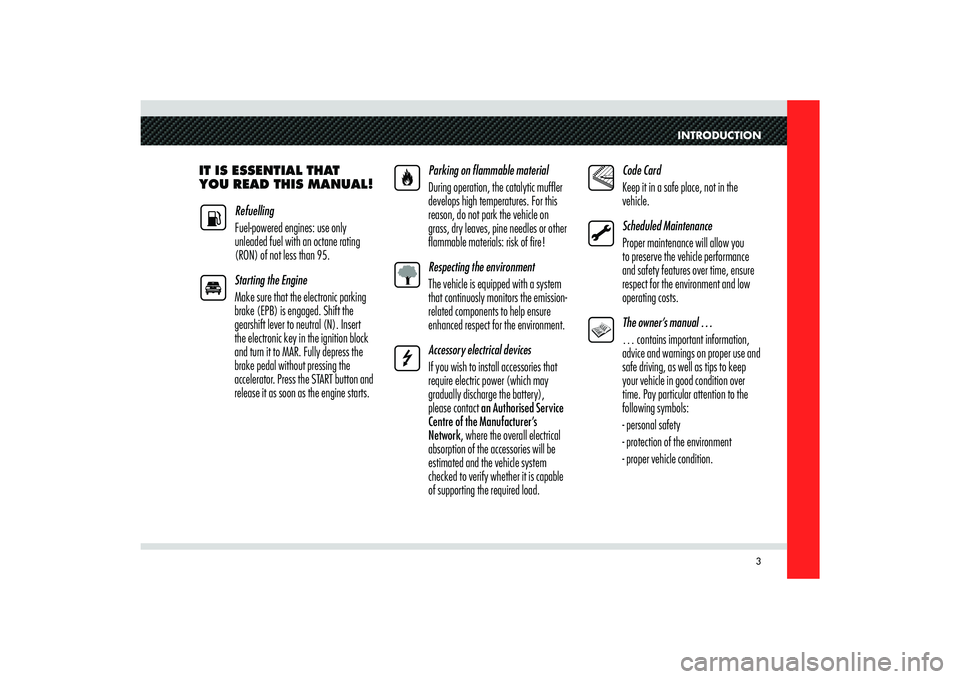
INTRODUCTION
3
IT IS ESSENTIAL THAT
YOU READ THIS MANUAL!
Refuelling
Fuel-powered engines: use only
unleaded fuel with an octane rating
(RON) of not less than 95.
Starting the Engine
Make sure that the electronic parking
brake (EPB) is engaged. Shift the
gearshift lever to neutral (N). Insert
the electronic key in the ignition block
and turn it to MAR. Fully depress the
brake pedal without pressing the
accelerator. Press the START button and
release it as soon as the engine starts.Parking on fl ammable material
During operation, the catalytic muffl er
develops high temperatures. For this
reason, do not park the vehicle on
grass, dry leaves, pine needles or other
fl ammable materials: risk of fi re!
Respecting the environment
The vehicle is equipped with a system
that continuosly monitors the emission-
related components to help ensure
enhanced respect for the environment.
Accessory electrical devices
If you wish to install accessories that
require electric power (which may
gradually discharge the battery),
please contact an Authorised Service
Centre of the Manufacturer’s
Network, where the overall electrical
absorption of the accessories will be
estimated and the vehicle system
checked to verify whether it is capable
of supporting the required load. Code Card
Keep it in a safe place, not in the
vehicle.
Scheduled Maintenance
Proper maintenance will allow you
to preserve the vehicle performance
and safety features over time, ensure
respect for the environment and low
operating costs.
The owner’s manual …
… contains important information,
advice and warnings on proper use and
safe driving, as well as tips to keep
your vehicle in good condition over
time. Pay particular attention to the
following symbols:
- personal safety
- protection of the environment
- proper vehicle condition.
Page 58 of 223
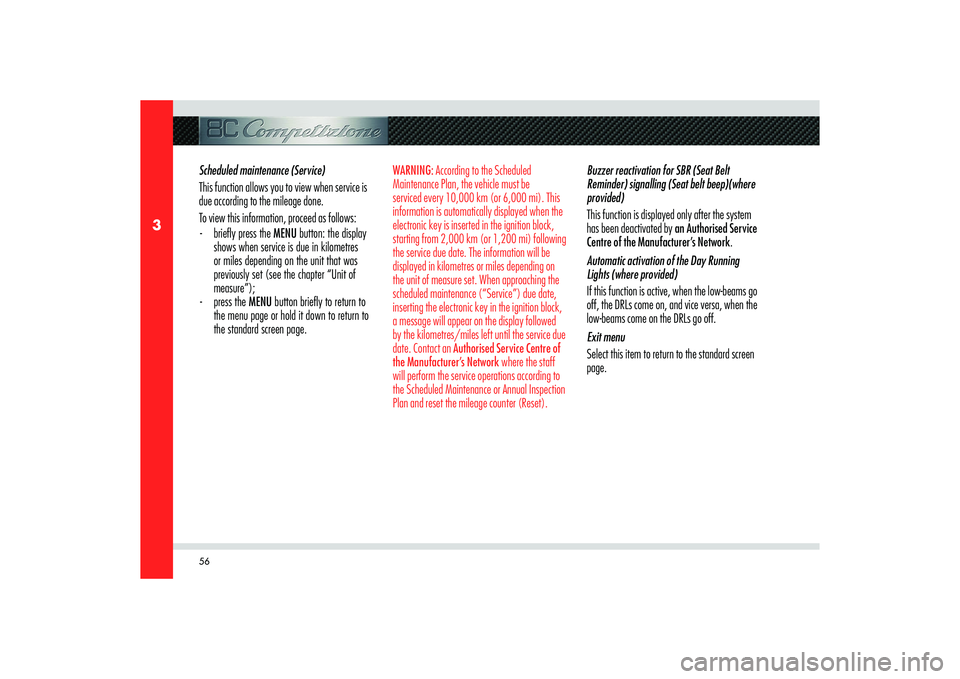
56
3
Scheduled maintenance (Service)
This function allows you to view when service is
due according to the mileage done.
To view this information, proceed as follows:
- briefl y press the MENU button: the display
shows when service is due in kilometres
or miles depending on the unit that was
previously set (see the chapter “Unit of
measure”);
- press the MENU button briefl y to return to
the menu page or hold it down to return to
the standard screen page.
WARNING: According to the Scheduled
Maintenance Plan, the vehicle must be
serviced every 10,000 km (or 6,000 mi). This
information is automatically displayed when the
electronic key is inserted in the ignition block,
starting from 2,000 km (or 1,200 mi) following
the service due date. The information will be
displayed in kilometres or miles depending on
the unit of measure set. When approaching the
scheduled maintenance (“Service”) due date,
inserting the electronic key in the ignition block,
a message will appear on the display followed
by the kilometres/miles left until the service due
date. Contact an Authorised Service Centre of
the Manufacturer’s Network where the staff
will perform the service operations according to
the Scheduled Maintenance or Annual Inspection
Plan and reset the mileage counter (Reset).
Buzzer reactivation for SBR (Seat Belt
Reminder) signalling (Seat belt beep)(where
provided)
This function is displayed only after the system
has been deactivated by an Authorised Service
Centre of the Manufacturer’s Network.
Automatic activation of the Day Running
Lights (where provided)
If this function is active, when the low-beams go
off, the DRLs come on, and vice versa, when the
low-beams come on the DRLs go off.
Exit menu
Select this item to return to the standard screen
page.
Page 132 of 223
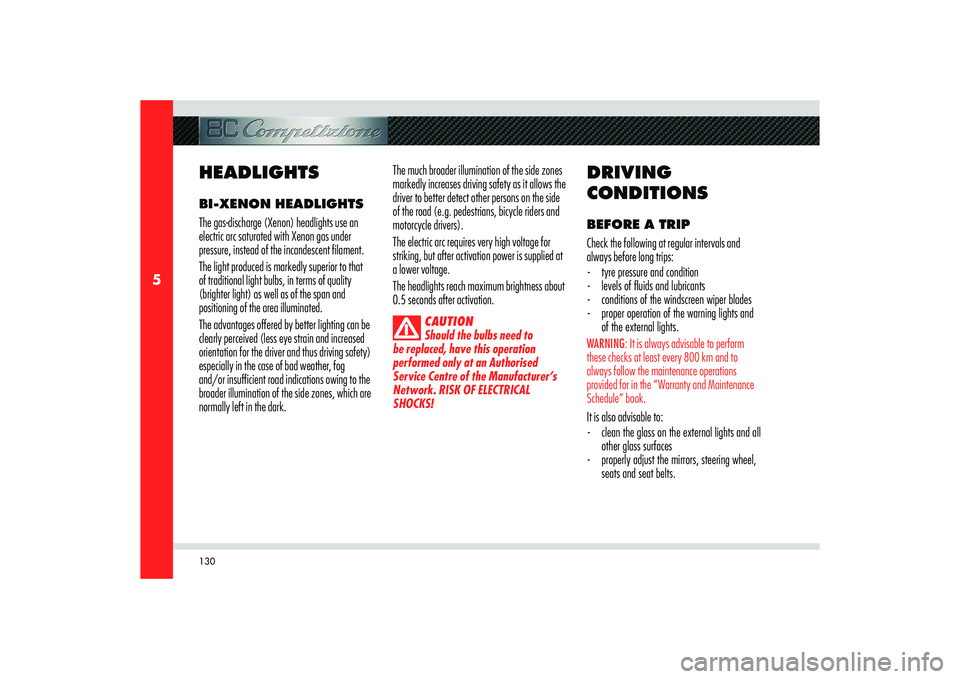
130
5
HEADLIGHTSBI-XENON HEADLIGHTS
The gas-discharge (Xenon) headlights use an
electric arc saturated with Xenon gas under
pressure, instead of the incandescent filament.
The light produced is markedly superior to that
of traditional light bulbs, in terms of quality
(brighter light) as well as of the span and
positioning of the area illuminated.
The advantages offered by better lighting can be
clearly perceived (less eye strain and increased
orientation for the driver and thus driving safety)
especially in the case of bad weather, fog
and/or insufficient road indications owing to the
broader illumination of the side zones, which are
normally left in the dark.The much broader illumination of the side zones
markedly increases driving safety as it allows the
driver to better detect other persons on the side
of the road (e.g. pedestrians, bicycle riders and
motorcycle drivers).
The electric arc requires very high voltage for
striking, but after activation power is supplied at
a lower voltage.
The headlights reach maximum brightness about
0.5 seconds after activation.
CAUTION
Should the bulbs need to
be replaced, have this operation
performed only at an Authorised
Service Centre of the Manufacturer’s
Network. RISK OF ELECTRICAL
SHOCKS!
DRIVING
CONDITIONSBEFORE A TRIP
Check the following at regular intervals and
always before long trips:
- tyre pressure and condition
- levels of fl uids and lubricants
- conditions of the windscreen wiper blades
- proper operation of the warning lights and
of the external lights.WARNING: It is always advisable to perform
these checks at least every 800 km and to
always follow the maintenance operations
provided for in the “Warranty and Maintenance
Schedule” book.It is also advisable to:
- clean the glass on the external lights and all
other glass surfaces
- properly adjust the mirrors, steering wheel,
seats and seat belts.
Page 137 of 223
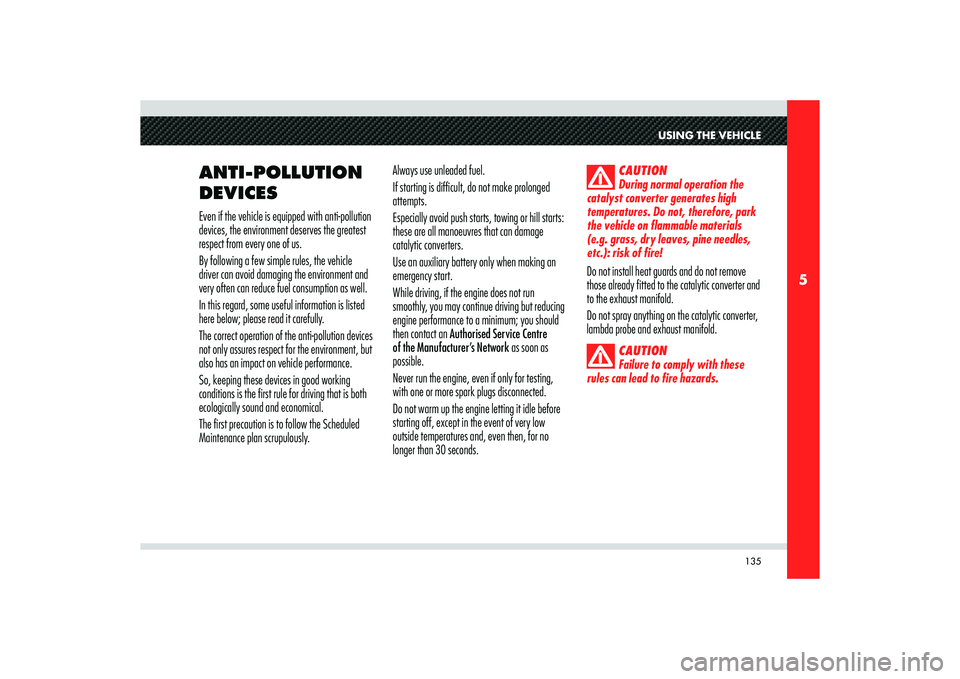
135
5
USING THE VEHICLE
ANTI-POLLUTION
DEVICES Even if the vehicle is equipped with anti-pollution
devices, the environment deserves the greatest
respect from every one of us.
By following a few simple rules, the vehicle
driver can avoid damaging the environment and
very often can reduce fuel consumption as well.
In this regard, some useful information is listed
here below; please read it carefully.
The correct operation of the anti-pollution devices
not only assures respect for the environment, but
also has an impact on vehicle performance.
So, keeping these devices in good working
conditions is the first rule for driving that is both
ecologically sound and economical.
The first precaution is to follow the Scheduled
Maintenance plan scrupulously. Always use unleaded fuel.
If starting is difficult, do not make prolonged
attempts.
Especially avoid push starts, towing or hill starts:
these are all manoeuvres that can damage
catalytic converters.
Use an auxiliary battery only when making an
emergency start.
While driving, if the engine does not run
smoothly, you may continue driving but reducing
engine performance to a minimum; you should
then contact an Authorised Service Centre
of the Manufacturer’s Network as soon as
possible.
Never run the engine, even if only for testing,
with one or more spark plugs disconnected.
Do not warm up the engine letting it idle before
starting off, except in the event of very low
outside temperatures and, even then, for no
longer than 30 seconds.
CAUTION
During normal operation the
catalyst converter generates high
temperatures. Do not, therefore, park
the vehicle on flammable materials
(e.g. grass, dry leaves, pine needles,
etc.): risk of fire!
Do not install heat guards and do not remove
those already fitted to the catalytic converter and
to the exhaust manifold.
Do not spray anything on the catalytic converter,
lambda probe and exhaust manifold.
CAUTION
Failure to comply with these
rules can lead to fire hazards.
Page 179 of 223
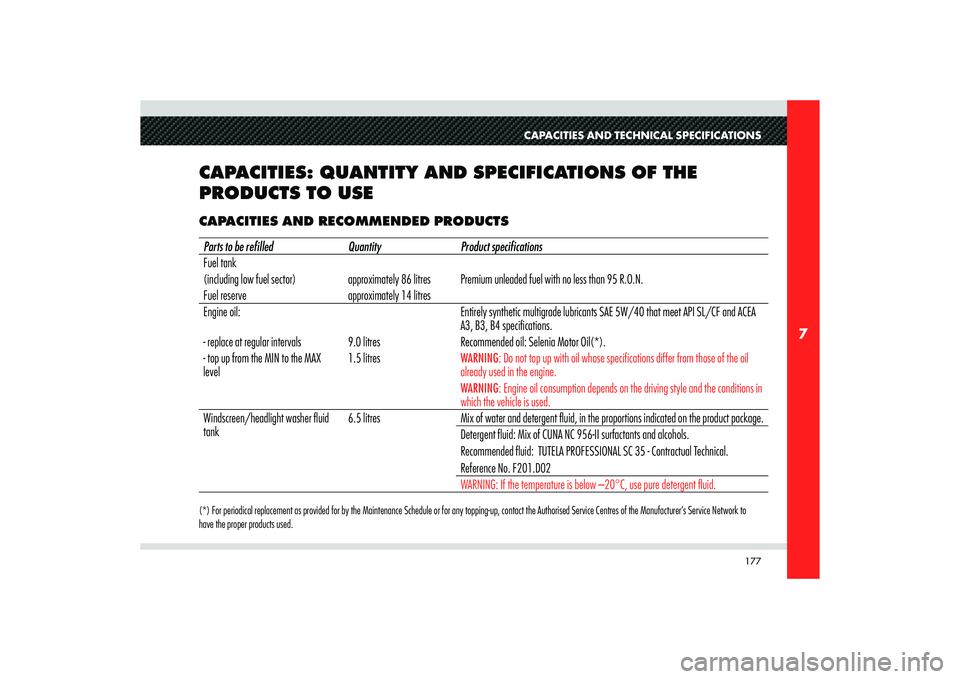
177
7
CAPACITIES AND TECHNICAL SPECIFICATIONS
CAPACITIES: QUANTITY AND SPECIFICATIONS OF THE
PRODUCTS TO USECAPACITIES AND RECOMMENDED PRODUCTS(*) For periodical replacement as provided for by the Maintenance Schedule or for any topping-up, contact the Authorised Service Centres of the Manufacturer’s Service Network to
have the proper products used. Parts to be refi lled Quantity Product specifi cations
Fuel tank
(including low fuel sector) approximately 86 litres Premium unleaded fuel with no less than 95 R.O.N.
Fuel reserve approximately 14 litres
Engine oil: Entirely synthetic multigrade lubricants SAE 5W/40 that meet API SL/CF and ACEA
A3, B3, B4 specifications.
- replace at regular intervals 9.0 litres Recommended oil: Selenia Motor Oil(*).
- top up from the MIN to the MAX
level1.5 litres
WARNING: Do not top up with oil whose specifications differ from those of the oil
already used in the engine.
WARNING: Engine oil consumption depends on the driving style and the conditions in
which the vehicle is used.
Windscreen/headlight washer fluid
tank6.5 litres Mix of water and detergent fluid, in the proportions indicated on the product package.
Detergent fluid: Mix of CUNA NC 956-II surfactants and alcohols.
Recommended fluid: TUTELA PROFESSIONAL SC 35 - Contractual Technical.
Reference No. F201.D02
WARNING: If the temperature is below –20°C, use pure detergent fluid.
Page 192 of 223

190
8
SCHEDULED
MAINTENANCECorrect maintenance is clearly the best way
to maintain vehicle performance and safety
features, ensure respect for the environment and
low operating costs.WARNING: Also remember that the scrupulous
observance of the maintenance procedures is
essential for the validity of the warranty.For this reason, Alfa Romeo has provided for
a series of checks and maintenance operations
involving the 1
st service when the vehicle
mileage reaches 5,000 km or after 6 months of
the vehicle life, and subsequently every 10,000
km or every year. AFTER THE 11
TH SERVICE
After the 11
th service, scheduled maintenance is
restarted with the same operations performed for
the 1
st, 2nd, 3rd Services
WARNING: The Scheduled Maintenance services
are prescribed by the Manufacturer. Failure to
have the services carried out invalidates the
warranty.
Scheduled Maintenance Services are
provided by all Authorised Service Centres
of the Manufacturer’s Network. In the
event that, when a service is performed,
further replacements or repairs are found to
be necessary in addition to the scheduled
operations, these can be carried out only with
the specific consent of the Customer. WARNING: We advise you to immediately
report to an Authorised Service Centre of the
Manufacturer’s Network any small operating
failures and not to wait for the next service.The Maintenance Schedule is contained in the
“Warranty and Maintenance Schedule” book.
Page 193 of 223

191
8
MAINTENANCE
The Scheduled Maintenance operations are
indicated on the display up to the ninth service
when the due date is approaching; this value is
shown in kilometres.
The message is displayed only once, upon
activating the instrument panel, at decreasing
intervals expressed in Km (1800, 1600, ......
100, 50).
Once the set limit in kilometres is reached, every
time the instrument panel is turned on thereafter,
the message “Service Stop expired” will be
displayed.Selecting the “Service” function from the Setup
menu, you can view when the next service is due
(see page 48).
Page 194 of 223
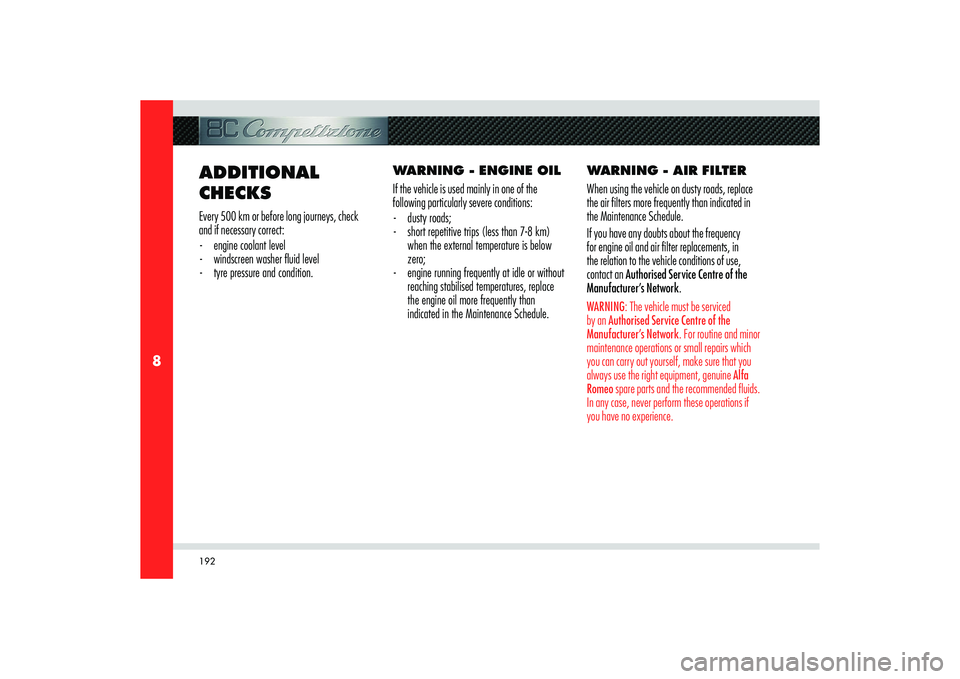
192
8
ADDITIONAL
CHECKSEvery 500 km or before long journeys, check
and if necessary correct:
- engine coolant level
- windscreen washer fl uid level
- tyre pressure and condition.WARNING - ENGINE OIL
If the vehicle is used mainly in one of the
following particularly severe conditions:
- dusty roads;
- short repetitive trips (less than 7-8 km)
when the external temperature is below
zero;
- engine running frequently at idle or without
reaching stabilised temperatures, replace
the engine oil more frequently than
indicated in the Maintenance Schedule. WARNING - AIR FILTER
When using the vehicle on dusty roads, replace
the air filters more frequently than indicated in
the Maintenance Schedule.
If you have any doubts about the frequency
for engine oil and air filter replacements, in
the relation to the vehicle conditions of use,
contact an Authorised Service Centre of the
Manufacturer’s Network.
WARNING: The vehicle must be serviced
by an Authorised Service Centre of the
Manufacturer’s Network. For routine and minor
maintenance operations or small repairs which
you can carry out yourself, make sure that you
always use the right equipment, genuine Alfa
Romeo spare parts and the recommended fluids.
In any case, never perform these operations if
you have no experience.
Page 199 of 223

197
8
MAINTENANCE
AIR FILTERHave the air filter replaced at an Authorised
Service Centre of the Manufacturer’s
Network.
ANTI-DUST/ANTI-
POLLEN FILTERThis filter performs mechanic/electrostatic air
filtering, provided that windows and doors are
fully closed.
Have the anti-pollen/dust filter replaced at least
once a year, at an Authorised Service Centre of
the Manufacturer’s Network preferably at the
beginning of the warm season.
If the vehicle is mainly used in the city traffic,
on highways or dusty roads, we recommend
that you replace the filters more frequently than
prescribed in the Maintenance Schedule.
WARNING: Failure to replace the filter may
considerably reduce the air conditioning and
heating system efficiency.
CAUTION
We advise you to have the
anti-pollen/dust filter replaced at
an Authorised Service Centre of the
Manufacturer’s Network.
Page 208 of 223

206
8
INTERIORSCheck at regular intervals that there is no water
trapped under the mats (due to drips off shoes,
umbrellas etc.) which may cause the metal parts
to oxidise.
CLEANING THE LEATHER
UPHOLSTERY
- Remove the dried dirt with a slightly damp
deerskin or a cloth, without rubbing too
hard.
- Remove any liquid or grease stains with a
dry absorbent cloth, without rubbing.
- Then run a soft cloth or deerskin damped
with water and neutral detergent.
- If the stain persists, use specifi c products
carefully following the instructions for use. WARNING: Never use alcohol, alcohol-based
products or solvents.
It is in any case advisable to use the Car Care
Kit (specifically for cleaning leather) included in
the Alfa Romeo accessory line. The kit cannot be
used on suede.
LEATHER UPHOLSTERY
TREATMENT
Have the leather upholstery treated according
to the Maintenance Schedule and only
at an Authorised Service Centre of the
Manufacturer’s Network, where the specific
products required for the treatment are available.CARBON PARTS
Have small scratches and marks on the carbon
structure removed by an Authorised Service
Centre of the Manufacturer’s Network.
Improper operations may irreparably damage the
carbon parts.
CAUTION
Do not use aggressive organic
substances, such as: petrol, kerosene,
petroleum, acetone or solvents.